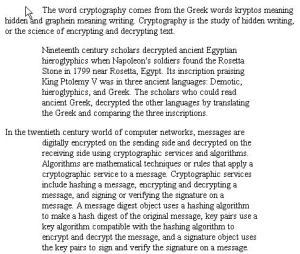Indenting Text
November 23, 2009 at 12:00 am 4 comments
The text-indent property provides an easy way to indent or outdent the first line of a paragraph, table cell, division, heading, or list item. Combining text-indent and a negative value with left padding creates an outdent.
CSS
/* indents first line */
*.indent{text-indent:60px;}
/* indents entire paragraph on the left and right */
*.fullparaindent{padding-left:60px; padding-right:60px;}
/* outdents first line */
*.outdent{text-indent:-60px;}
HTML
<p class="indent">
The word cryptography comes from the Greek words kryptos meaning hidden and graphein meaning writing. Cryptography is the study of hidden writing, or the science of encrypting and decrypting text.
</p> <p class="fullparaindent">
Nineteenth century scholars decrypted ancient Egyptian hieroglyphics when Napoleon’s soldiers found the Rosetta Stone in 1799 near Rosetta, Egypt. Its inscription praising King Ptolemy V was in three ancient languages: Demotic, hieroglyphics, and Greek. The scholars who could read ancient Greek, decrypted the other languages by translating the Greek and comparing the three inscriptions.
</p>
<p class="fullindent outdent">
In the twentieth century world of computer networks, messages are digitally encrypted on the sending side and decrypted on the receiving side using cryptographic services and algorithms. Algorithms are mathematical techniques or rules that apply a cryptographic service to a message. Cryptographic services include hashing a message, encrypting and decrypting a message, and signing or verifying the signature on a message. A message digest object uses a hashing algorithm to make a hash digest of the original message, key pairs use a key algorithm compatible with the hashing algorithm to encrypt and decrypt the message, and a signature object uses the key pairs to sign and verify the signature on a message.
</p>
What it Looks Like
Adding a Spacer
If you want to add a space within inline content, you can do that with a spacer:
CSS
*.spacer{margin-left:10px;}
HTML
<p>
→ The Java Cryptography Architecture (JCA) framework in the Java Development Kit (JDK) 1.2 provides a full range of cryptographic services and algorithms to keep messages sent over the network secure. → The framework is extensible and interoperable. → Not only can you add cryptographic service implementations by different vendors to the framework, but, for example, the signature service implementation by one vendor will work seamlessly with the signature service implementation by another vendor as long as both vendors’ implementations use the same signature algorithm. → Given how implementations can vary from vendor to vendor, the flexibility built into the JCA framework lets you choose an implementation that best meets your application requirements.
</p>
What it Looks Like
 Code
Code
<html>
<head><title>Text Indent</title>
<style type=’text/css’>
body{padding:10px; border:1px solid #00008b;}
*.indent{text-indent:60px;}
*.fullindent{padding-left:60px; padding-right:60px;}
*.outdent{text-indent:-60px;}
*.spacer{margin-left:10px;}
</style>
</head>
<body>
<p>
The word cryptography comes from the Greek words kryptos meaning hidden and graphein meaning writing. Cryptography is the study of hidden writing, or the science of encrypting and decrypting text.
</p>
<p>
Nineteenth century scholars decrypted ancient Egyptian hieroglyphics when Napoleon’s soldiers found the Rosetta Stone in 1799 near Rosetta, Egypt. Its inscription praising King Ptolemy V was in three ancient languages: Demotic, hieroglyphics, and Greek. The scholars who could read ancient Greek, decrypted the other languages by translating the Greek and comparing the three inscriptions.
</p>
<p>
In the twentieth century world of computer networks, messages are digitally encrypted on the sending side and decrypted on the receiving side using cryptographic services and algorithms. Algorithms are mathematical techniques or rules that apply a cryptographic service to a message. Cryptographic services include hashing a message, encrypting and decrypting a message, and signing or verifying the signature on a message. A message digest object uses a hashing algorithm to make a hash digest of the original message, key pairs use a key algorithm compatible with the hashing algorithm to encrypt and decrypt the message, and a signature object uses the key pairs to sign and verify the signature on a message.
</p>
<p>
→ The Java Cryptography Architecture (JCA) framework in the Java Development Kit (JDK) 1.2 provides a full range of cryptographic services and algorithms to keep messages sent over the network secure. → The framework is extensible and interoperable. → Not only can you add cryptographic service implementations by different vendors to the framework, but, for example, the signature service implementation by one vendor will work seamlessly with the signature service implementation by another vendor as long as both vendors’ implementations use the same signature algorithm. → Given how implementations can vary from vendor to vendor, the flexibility built into the JCA framework lets you choose an implementation that best meets your application requirements.
</p>
<p>
Read the full article, monica/articles/crypto/”>Cryptography: The Ancient Art of Secret Messages
</body>
</html>
Read the full article, Cryptography: The Ancient Art of Secret Messages
Entry filed under: Text Styling. Tags: content indent, content outdent, spacing content.
4 Comments Add your own
Leave a comment
Trackback this post | Subscribe to the comments via RSS Feed

1. cime_ro | September 9, 2010 at 10:50 am
cime_ro | September 9, 2010 at 10:50 am
good tutorial !
2. Josh | December 5, 2010 at 4:33 pm
Josh | December 5, 2010 at 4:33 pm
loved the way you said it, keep it coming! קידום אתרים
3. Josh | December 6, 2010 at 8:17 am
Josh | December 6, 2010 at 8:17 am
i rarely reply in blogs, but there is a few that i follow a lot.
thank you for your postings, love them. קידום אתרים
4. קידום אתרים מקצועי | June 3, 2012 at 3:46 am
קידום אתרים מקצועי | June 3, 2012 at 3:46 am
Hi there, I found your website by way of Google even as looking for a similar topic, your web site came up, it looks great. I have bookmarked to favourites|added to my bookmarks.